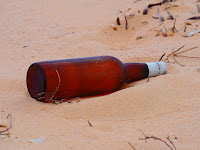This is the story of a semi-grey nomad's ground breaking attempt to circumnavigate the Peron Peninsular, hiking mainly on the beach from Denham to Monkey Mia.
Day 4: From Skipjack Point to Herald bight. North to South.
Standing on the edge of a steep cliff next to the light house at Skipjack Point my knowledgeable companion pointed out controversially how global warming had affected this area. "There used to be a goat's trail down towards the beach but it looks like it is all washed away by the ocean" he said. "You've gotta find yer own way down further on". Off I went, following a tiny trail high above the beach. I could only see goat and kangaroo prints on this trail. The soft sand and up and down nature of the trail soon had my heart rate up high. In some places my shins got a good scratching from low, sharp bush I still don't recognise. After about 500 metres my precarious balancing act on the ledge had come to an end when my patience was rewarded with a safe passage down to the beach below. Any attempt to decend before that would had been foolish and would have come to a sticky end.
At the first rocky point I rounded, I pathetically slipped on a wet rock and both my feet slipped into the water. As you can see, unexpected small incidents always happen on hikes like this no matter how experienced you think you are. I took my shoes and socks off against my better judgement and dangled them off my pack in the hope for them to dry. |
| A slippy rock formation |
 |
| Selfie of size 13 foot in crystal clear water |
Walking bare feet is always a risk in these parts and I took a fair amount of skin off my big toe when my foot met a much more rigid object called "a rock". I am sure something nasty happened to my 'second toe in command' ranging from a mild sprain to a small split in the bone perhaps. Just keep going Mars! At least my socks were dry!!!!!
 |
| A sea-gull in full flight |
Having rebooted my feet, I noticed there were a few washed up items laying around on the beach. I could have built a life raft out of all the washed up water containers. There was no message in this bottle, nor was there a naked woman running around that belonged to these undies.
 |
| Love heart tiger undies??? |
On the muddy flats that I was walking, many birds appeared. Sea-gulls, oyster catchers, turns and lesser sand plovers. The last are these cute little foragers that will not let you anywhere more than about 15 metres near them. They must be amazing flyers as they lay their eggs above the tree line in the Himalayas and then visit us in Australia.
 |
| The Lesser Sand Plover no less |
This bunch of goats came running towards me and looked inquiringly at me from about 50 metres. At one point I was rummaging around for my "self defence booklet against goats" but I courageously stared them down. Amazingly, to avoid my glaring gaze, they randomly ran up that same steep cliff I had just walked 500 meters along to find a safe way down.

 |
| Ninja goats |
Today's pick up was a smooth affair with my man of know-how appearing at Herald Bight as soon as I limped onto its white sand.
 |
| Another day, another shark |
Grey Bits
To avoid having to hike on a rocky, dangerous ledge I suggest that one could start walking along the beach from Cape Peron and rounding Skipjack Point down below. It is a little bit further, but it is a lot safer option.
Today's walk is approximately 12km long and could easily be done as a day walk with car access on both ends.
Please note, that this hike is through very wild, uninhabited country. In my opinion it is not advisable to attempt this hike without a support team or proper communication devices like a satellite phone or EPIRB. Hiking experience in this area is a must.
 |
| A shovelnose ray |
Let the Department of Parks and Wildlife know where you are going to be and when you plan to return. Phone (08) 9948 2226 or click on the following links www.sharkbay.org, www.dpaw.wa.gov.au for more information.
The best time to walk around the Peron Peninsular is at low tide. You can check the tide at www.seabreeze.com.au
 |
| Pied oystercatcher |





































